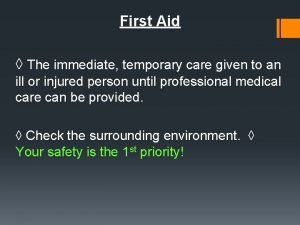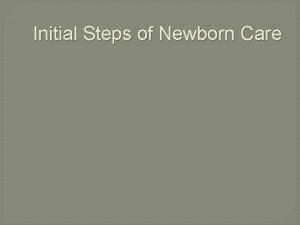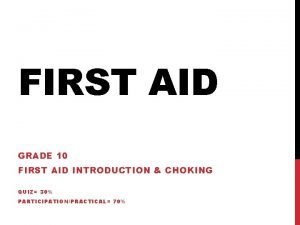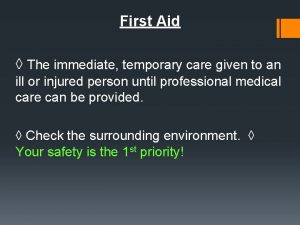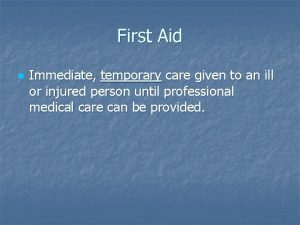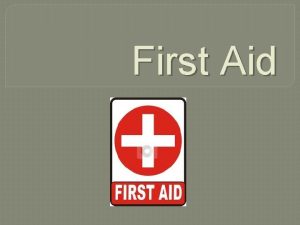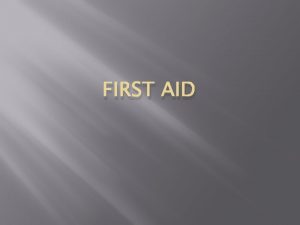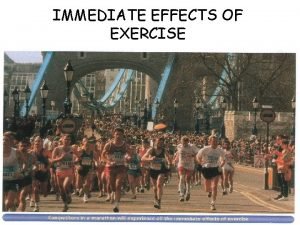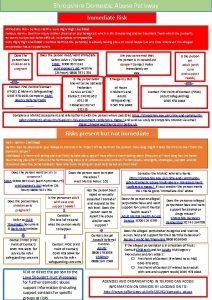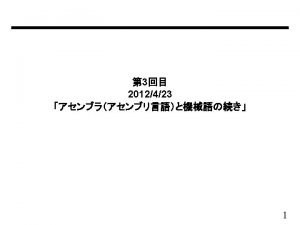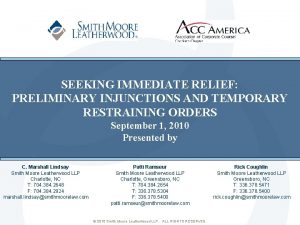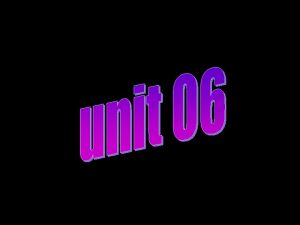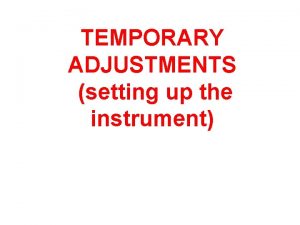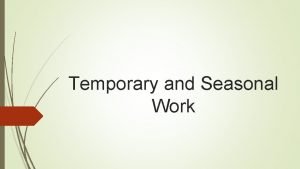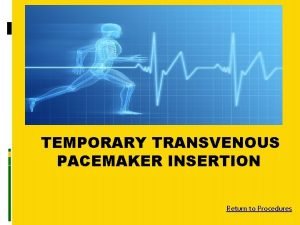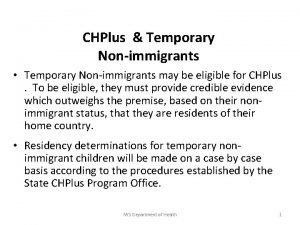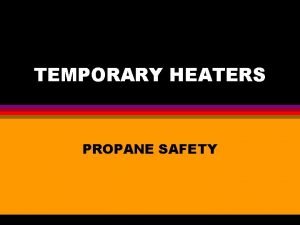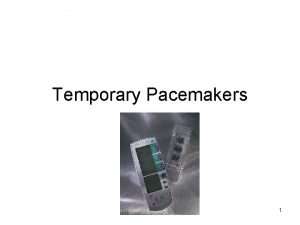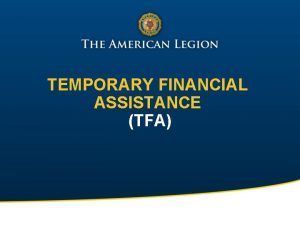FIRST AID FIRST AID The immediate temporary care











































- Slides: 43

FIRST AID

FIRST AID The immediate, temporary care given to an ill or injured person until professional medical care can be provided

types of open wounds

Abrasions � Known as scrapes. These occur when the skin is scraped against a hard surface, bursting the tiny blood vessels in outer layer of skin. � Chief danger is bacteria and dirt can penetrate the skin.

Abrasions � Known as scrapes. These occur when the skin is scraped against a hard surface, bursting the tiny blood vessels in outer layer of skin. � Chief danger is bacteria and dirt can penetrate the skin. � Important to clean the wound well to prevent infection and speed healing

Lacerations � These are cuts caused by sharp object slicing through layers of skin. � Minor lacerations can be treated at home, but if cut is deep, on the face or neck, and/or won’t stop bleeding, medical care is needed.

Lacerations � These are cuts caused by sharp object slicing through layers of skin. � Minor lacerations can be treated at home, but if cut is deep, on the face or neck, and/or won’t stop bleeding, medical care is needed. These wounds may require stitches. A tetanus booster may also be needed.

Punctures �A small deep hole caused by a sharp and narrow object (such as a nail) that pierces the skin. � May not cause much bleeding, but carry high risk of infection. If a puncture is deep, dirty or in the foot, see a doctor.

Punctures �A small deep hole caused by a sharp and narrow object (such as a nail) that pierces the skin. � May not cause much bleeding, but carry high risk of infection. If a puncture is deep, dirty or in the foot, see a doctor. � May need a tetanus shot or booster

Avulsions � Skin or tissue is partly or completely torn away.

Avulsions � Skin or tissue is partly or completely torn away. � Wounds usually require stitches

Avulsions � Skin or tissue is partly or completely torn away. � Wounds � Body usually require stitches part is detached: If possible, wrap in cold moist towel to preserve the tissue. Doctors may be able to reattach.

controlling bleeding � If possible, raise body part above the heart � Cover the wound with a sterile gauze or clean cloth � Press your palm firmly against the gauze. Apply steady pressure for 5 minutes or until help arrives. DO NOT stop to check the wound, you could interrupt the blood clotting � If blood soaks through the gauze, add another gauze and continue the pressure, DO NOT remove soaked gauzes.

controlling bleeding � Once the bleeding slows or stops, secure the pad in place with a bandage. � If you can't stop the bleeding after 5 minutes, call medical help if haven't already done so and keep pressure on wound until help arrives � Watch the videos on Bleeding: � 1. https: //youtu. be/md. NKB 6 q. Lv. T 0? list=PLf. Ij. AEIO 4 Jv. SVT 7 l. RGo 0 YAx_2 Hd. B 6 hs. Uf � 2. https: //youtu. be/q. Ka. Mt. MPUKk 4? list=PLf. Ij. AEIO 4 Jv. SVT 7 l. RGo 0 YAx_2 Hd. B 6 hs. Uf � 3. https: //youtu. be/gxx. C 4 Jx. BZz 4? list=PLf. Ij. AEIO 4 Jv. SVT 7 l. RGo 0 YAx_2 Hd. B 6 hs. Uf

first aid for burns https: //youtu. be/xb 8 D 0 V 5 x. G 8? list=PLf. Ij. AEIO 4 Jv. SVT 7 l. RGo 0 YAx_2 Hd. B 6 hs. Uf ^^^^^^^ Watch video on BURNS ^^^^^^^

first degree burn � Involve only the outer layer (epidermis) of skin � Skin becomes red, and the burned area may become swollen and painful

second degree burn � Involve the outer layer of skin and also the underlying layers of skin (the dermis) � Skin becomes very red and develops blisters � Severe pain and swelling and no larger than 2 -3 inches in diameter.

st first aid for 1 degree and nd small 2 degree burns 1. 2. 3. 4. Cool the burned area by holding under cold running water for at least 5 minutes. Do Not use ice-may cause frostbite to the skin Cover the burn loosely with a sterile gauze bandage Victim may take a over the counter medicine Minor burns usually heal without further treatment

third degree burn � The most serious burn, involves all layers of skin and may penetrate the underlying tissues. � Skin may be charred black or may appear white and dry � May see muscle and bone and victim may feel no pain because nerve endings are destroyed

first aid for some 2 nd degree and all 3 rd degree burns 1. 2. 3. 4. 5. 6. Require immediate medical care Call 911 and provide first aid Cover the burned area with a clean moist cloth DO NOT remove burned clothing unless it is still smoldering DO Not immerse burned area into cold water, may put victim into shock Be ready to treat victim for shock

first aid for shock � Shock: A life threatening condition in which the heart is not delivering an adequate supply of blood to the body � Symptoms: ◦ ◦ Cold, clammy skin, which may appear pale or grayish Weak, rapid pulse and altered breathing Dull, staring eyes, which may have dilated pupils Faintness, weakness, confusion, or loss of consciousness ◦ https: //www. youtube. com/a 8 c 56684 -19 a 4 -4 c 51 -82 e 0 -6 bbf 24275 b 61 (Click on Video)

first aid for shock � If ◦ ◦ ◦ ◦ someone displays the symptoms of shock: Call 911 Get victim to lie down Raise feet about 12 inches May become agitated, keep them calm Be prepared to administer CPR Loosen clothes and keep them warm and comfortable DO NOT give them anything to eat or drink

STRAIN vs SPRAIN �Strain: a tear in a muscle �Watch Video on STRAINS VS SPRAINS �https: //youtu. be/W_Ugy. XK 8 ej 4? list=PLf. Ij. AEIO 4 Jv. SVT 7 l. RGo 0 YAx_2 Hd. B 6 hs. Uf

STRAIN vs SPRAIN �Strain: a tear in a muscle �Sprain: an injury to the ligaments around the joint

STRAIN vs SPRAIN �Strain: a tear in a muscle �Sprain: an injury to the ligaments around the joint �Both injuries have similar symptoms: pain, stiffness, swelling, and bruising of surrounding skin

Treatment for minor sprains and strains �P �R �I �C �E

Treatment for minor sprains and strains � Protect the affected area by wrapping the area in a bandage or splint �R �I �C �E

Treatment for minor sprains and strains � Protect the affected area by wrapping the area in a bandage or splint � Rest the injured body part �I �C �E

Treatment for minor sprains and strains � Protect the affected area by wrapping the area in a bandage or splint � Rest the injured body part � Ice �C �E the area to reduce swelling and pain.

Treatment for minor sprains and strains � Protect the affected area by wrapping the area in a bandage or splint � Rest the injured body part � Ice the area to reduce swelling and pain. � Compress �E the injury by wrapping firmly

Treatment for minor sprains and strains � Protect the affected area by wrapping the area in a bandage or splint � Rest the injured body part � Ice the area to reduce swelling and pain. � Compress � Elevate the injury by wrapping firmly the injured body part higher than level of heart

fractures and dislocations � Fracture: break in the bone

fractures and dislocations � Fracture: break in the bone � Dislocation: separation of a bone from its normal position in a joint

fractures and dislocations First aid for fractures and dislocations: 1. Call 911

fractures and dislocations First aid for fractures and dislocations: 1. Call 911 2. Keep victim still and calm

fractures and dislocations First aid for fractures and dislocations: 1. Call 911 2. Keep victim still and calm 3. If skin is broke, rinse carefully to try and stop infection. DO NOT disturb bone. Cover with sterile dressing if possible

fractures and dislocations First aid for fractures and dislocations: 1. Call 911 2. Keep victim still and calm 3. If skin is broke, rinse carefully to try and stop infection. DO NOT disturb bone. Cover with sterile dressing if possible 4. Apply splint if possible

fractures and dislocations First aid for fractures and dislocations: 1. Call 911 2. Keep victim still and calm 3. If skin is broke, rinse carefully to try and stop infection. DO NOT disturb bone. Cover with sterile dressing if possible 4. Apply splint if possible 5. Apply ice help to reduce pain and swelling

Fainting �A temporary loss of consciousness that occurs when not enough blood is flowing to the brain ◦ If see someone fainting, try and catch and stop them from falling ◦ Lay on floor and elevate the feet ◦ Loosen tight clothing around the neck ◦ If vomit, quickly roll on side ◦ If don’t regain consciousness in a few minutes, call 911 ◦ Put a damp cloth on forehead ◦ https: //youtu. be/ro 2 qjo. Ytn_Q? list=PLf. Ij. AEIO 4 Jv. SVT 7 l. RGo 0 YA x_2 Hd. B 6 hs. Uf Watch Video on Fainting

concussion �A jarring injury to the brain that can cause unconsciousness ◦ Any person who loses consciousness or experiences memory loss or confusion because of a head injury may have a concussion ◦ https: //youtu. be/ml. Wa. Byo. T 24 s? list=PLf. Ij. AEIO 4 Jv. SVT 7 l. RGo 0 Y Ax_2 Hd. B 6 hs. Uf (watch video)

Nosebleeds � Sit down and squeeze the soft part of the nose between your thumb and finger � Lean forward � Keep head above the heart � Don’t lay down

Snakebites � Venom: ◦ ◦ ◦ a poisonous secretion Call 911 Try and keep victim from moving Keep affected area below level of heart Remove rings and other constricting items, since affected area may swell up DO NOT apply a tourniquet, use cold compresses, cut into the bitten area or suck the venom out https: //youtu. be/9 q. YAPh. NTkl 0? list=PLf. Ij. AEIO 4 Jv. SVT 7 l. RGo 0 YAx_2 Hd. B 6 hs. Uf ^^^^^^ Watch Video on Snake Bites ^^^^ ◦

Insect and spider bites and stings � Remove stinger by scraping off with a firm object like a credit card. DO NOT use tweezers, since they may squeeze more venom into the victim � Wash with mild soap and water � Apply ice � May put on some anti itch creams � If a severe reaction occurs, call 911
 What do you call the immediate and temporary
What do you call the immediate and temporary First aid merit badge first aid kit
First aid merit badge first aid kit Apgar score 8
Apgar score 8 Meconimum
Meconimum Objectives of newborn care
Objectives of newborn care Primary secondary tertiary health care definition
Primary secondary tertiary health care definition Pa wc bureau
Pa wc bureau Chapter 8 emergency care first aid and disasters
Chapter 8 emergency care first aid and disasters Objective of first aid
Objective of first aid Green hill park medical centre
Green hill park medical centre Hình ảnh bộ gõ cơ thể búng tay
Hình ảnh bộ gõ cơ thể búng tay Ng-html
Ng-html Bổ thể
Bổ thể Tỉ lệ cơ thể trẻ em
Tỉ lệ cơ thể trẻ em Gấu đi như thế nào
Gấu đi như thế nào Tư thế worm breton
Tư thế worm breton Chúa yêu trần thế alleluia
Chúa yêu trần thế alleluia Môn thể thao bắt đầu bằng từ chạy
Môn thể thao bắt đầu bằng từ chạy Thế nào là hệ số cao nhất
Thế nào là hệ số cao nhất Các châu lục và đại dương trên thế giới
Các châu lục và đại dương trên thế giới Công của trọng lực
Công của trọng lực Trời xanh đây là của chúng ta thể thơ
Trời xanh đây là của chúng ta thể thơ Cách giải mật thư tọa độ
Cách giải mật thư tọa độ Làm thế nào để 102-1=99
Làm thế nào để 102-1=99 Phản ứng thế ankan
Phản ứng thế ankan Các châu lục và đại dương trên thế giới
Các châu lục và đại dương trên thế giới Thơ thất ngôn tứ tuyệt đường luật
Thơ thất ngôn tứ tuyệt đường luật Quá trình desamine hóa có thể tạo ra
Quá trình desamine hóa có thể tạo ra Một số thể thơ truyền thống
Một số thể thơ truyền thống Cái miệng xinh xinh thế chỉ nói điều hay thôi
Cái miệng xinh xinh thế chỉ nói điều hay thôi Vẽ hình chiếu vuông góc của vật thể sau
Vẽ hình chiếu vuông góc của vật thể sau Nguyên nhân của sự mỏi cơ sinh 8
Nguyên nhân của sự mỏi cơ sinh 8 đặc điểm cơ thể của người tối cổ
đặc điểm cơ thể của người tối cổ V cc
V cc Vẽ hình chiếu đứng bằng cạnh của vật thể
Vẽ hình chiếu đứng bằng cạnh của vật thể Phối cảnh
Phối cảnh Thẻ vin
Thẻ vin đại từ thay thế
đại từ thay thế điện thế nghỉ
điện thế nghỉ Tư thế ngồi viết
Tư thế ngồi viết Diễn thế sinh thái là
Diễn thế sinh thái là Các loại đột biến cấu trúc nhiễm sắc thể
Các loại đột biến cấu trúc nhiễm sắc thể Số.nguyên tố
Số.nguyên tố Tư thế ngồi viết
Tư thế ngồi viết
